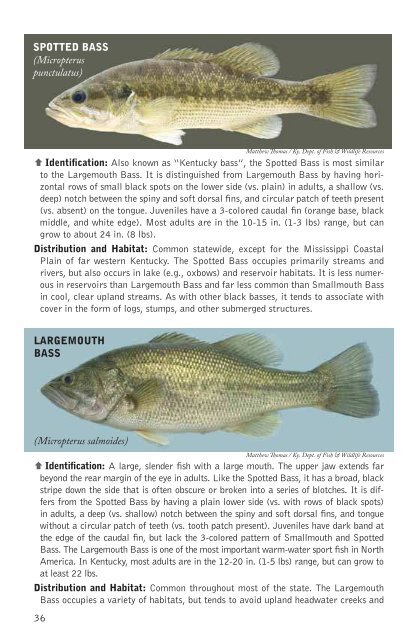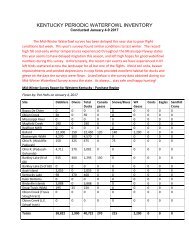Kentucky Fishes
kyfishid[1]
kyfishid[1]
- No tags were found...
Create successful ePaper yourself
Turn your PDF publications into a flip-book with our unique Google optimized e-Paper software.
SPOTTED BASS<br />
(Micropterus<br />
punctulatus)<br />
small streams. It is a common inhabitant of ponds, reservoirs, backwaters, oxbows,<br />
and sloughs, where it is usually associated with shallow, vegetated areas, standing<br />
timber, stumps, and other cover. This species is widely stocked throughout the state,<br />
from private ponds to large reservoirs, as well as the <strong>Kentucky</strong> and Ohio rivers.<br />
Ç Identification: Also known as “<strong>Kentucky</strong> bass”, the Spotted Bass is most similar<br />
to the Largemouth Bass. It is distinguished from Largemouth Bass by having horizontal<br />
rows of small black spots on the lower side (vs. plain) in adults, a shallow (vs.<br />
deep) notch between the spiny and soft dorsal fins, and circular patch of teeth present<br />
(vs. absent) on the tongue. Juveniles have a 3-colored caudal fin (orange base, black<br />
middle, and white edge). Most adults are in the 10-15 in. (1-3 lbs) range, but can<br />
grow to about 24 in. (8 lbs).<br />
Distribution and Habitat: Common statewide, except for the Mississippi Coastal<br />
Plain of far western <strong>Kentucky</strong>. The Spotted Bass occupies primarily streams and<br />
rivers, but also occurs in lake (e.g., oxbows) and reservoir habitats. It is less numerous<br />
in reservoirs than Largemouth Bass and far less common than Smallmouth Bass<br />
in cool, clear upland streams. As with other black basses, it tends to associate with<br />
cover in the form of logs, stumps, and other submerged structures.<br />
LARGEMOUTH<br />
BASS<br />
(Micropterus salmoides)<br />
Matthew Thomas / Ky. Dept. of Fish & Wildlife Resources<br />
Matthew Thomas / Ky. Dept. of Fish & Wildlife Resources<br />
Ç Identification: A large, slender fish with a large mouth. The upper jaw extends far<br />
beyond the rear margin of the eye in adults. Like the Spotted Bass, it has a broad, black<br />
stripe down the side that is often obscure or broken into a series of blotches. It is differs<br />
from the Spotted Bass by having a plain lower side (vs. with rows of black spots)<br />
in adults, a deep (vs. shallow) notch between the spiny and soft dorsal fins, and tongue<br />
without a circular patch of teeth (vs. tooth patch present). Juveniles have dark band at<br />
the edge of the caudal fin, but lack the 3-colored pattern of Smallmouth and Spotted<br />
Bass. The Largemouth Bass is one of the most important warm-water sport fish in North<br />
America. In <strong>Kentucky</strong>, most adults are in the 12-20 in. (1-5 lbs) range, but can grow to<br />
at least 22 lbs.<br />
Distribution and Habitat: Common throughout most of the state. The Largemouth<br />
Bass occupies a variety of habitats, but tends to avoid upland headwater creeks and<br />
WHITE CRAPPIE<br />
(Pomoxis<br />
annularis)<br />
Å Identification:<br />
A silvery sunfish<br />
with a deep<br />
body that is very<br />
thin from side to<br />
side. The mouth<br />
is large and<br />
the upper jaw<br />
extends to below<br />
the middle of<br />
the eye. Color<br />
is dark olive on<br />
the back and<br />
silver on the sides, with several dark vertical bars (often faint). The dorsal fin has 6<br />
spines. Adults can grow to 21 in. (5 lbs), but most range from 8-15 in. (1-2 lbs).<br />
Distribution and Habitat: Common statewide in streams, rivers, and reservoirs. In<br />
streams and rivers, preferred habitat includes backwaters or pools around cover in<br />
the form of log jams, undercut banks, and submerged vegetation. The White Crappie<br />
is stocked throughout the state in reservoirs, where it associates with brush piles,<br />
standing timber, rock ledges, and other cover.<br />
BLACK CRAPPIE<br />
(Pomoxis<br />
nigromaculatus)<br />
Matthew Thomas / Ky. Dept. of Fish & Wildlife Resources<br />
Matthew Thomas / Ky. Dept. of Fish & Wildlife Resources<br />
Å Identification:<br />
Similar to the<br />
White Crappie,<br />
but differs by<br />
having a shorter<br />
body between the<br />
snout and dorsal<br />
fin origin, 7-8<br />
(vs. 6) dorsal-fin<br />
spines, and sides<br />
more boldy patterned<br />
with dark<br />
green or black<br />
speckles and<br />
blotches (vs. sides<br />
with dark vertical bars). Adults can grow to 19 in. (6 lbs), but most range from<br />
8-15 in. (1-2 lbs).<br />
Distribution and Habitat: Occurs statewide in streams, rivers, and reservoirs, but less<br />
common than White Crappie. Habitat requirements are similar to those of White Crappie,<br />
but less tolerant of turbid (muddy) waters. The Black Crappie tends to be more<br />
abundant in natural lakes (e.g, oxbows) and reservoirs having clearer water.<br />
36 37



